



Furtherfield is pleased to present the UK Book launch of STATION ROSE: 20 Digital Years Plus, published by Verlag für Moderne Kunst Nürnberg.
DR. Richard Barbrook will give a short introduction to the evening.
The Digital Art of Station Rose started in Vienna in 1988, at a time when the Web still was far beyond mainstream, when Mondo 2000 never had heard about the music genre “Techno”, when future net-art-critics still mostly were university students, and when the Iron Curtain was surrounding Austria´s east, south east and north border.
“Station Rose had every right to claim ‘cyberspace is our land.’ They were there very early, they raised their antennas and put down deep roots, and they never left.” – Bruce Sterling, 2010
Station Rose, pioneers of digital culture, have produced an artist’s book which delivers a current description of the situation of media art from 1988, when the studio was founded, until 2010. Station Rose (Elisa Rose and Gary Danner) are considered to be innovators and visionaries in the field of audiovisual art, electronic music, net art and audiovisual live performance. The book features audio-visual works, performances, installations and Web 2.0 activities and linkings. Part of the book is dedicated to the media sculpture LoginCabin exhibited for three months in 2009 in the MAK in Vienna.
The latest art of Station Rose refracts the logistics and glitches of the Internet through the deceptively low-fi aesthetic of contemporary art’s installations and performances. “Twenty Digital Years Plus” shows how this fits into their history of using the viruses of visual, verbal and computer language to find insightful ways of conceptualising digital culture.
RSVP – Please contact Ale Scapin
http://www.stationrose.com/STR-Books/20DYplus-book.html
http://www.furtherfield.org/contact
Station Rose 20 Digital Years plus. 1988–2010 –>
paperbook with flaps 16,5 x 22 cm
192 pages., german/engl.
Euro 40,00/sFr 64,00
ISBN 978-3-86984-111-3
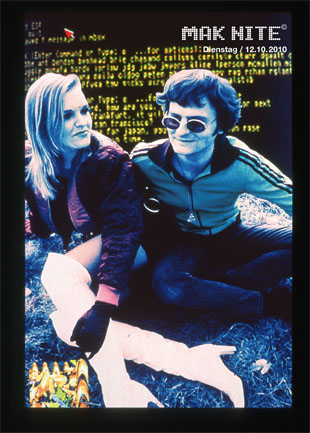
Peter Noever (preface), Howard Rheingold, Bruce Sterling, Gabriele Horn, Vitus H.Weh, Didi Neidhart, Peter Weibel, Dr.Hans Diebner, Christoph Tannert, David Hudson, Terence McKenna, Elisabeth Zimmermann, Doug Millison, Dr.Timothy Leary, Elisa Rose, STR, u. a.
Österreichisches Kulturforum Berlin, Stadt Frankfurt am Main – Dezernat für Kultur und Wissenschaft, BMUKK Wien, Hessisches Ministerium für Wissenschaft und Kunst, Kultur Land Oberösterreich.
Distributed in the United Kingdom
Cornerhouse Publications
70 Oxford Street, Manchester M1 5 NH, UK
phone +44-161-200 15 04, fax +44-161-200 15 04
Distributed outside Europe
D.A.P. Distributed Art Publishers, Inc.
155 Sixth Avenue, 2nd Floor, New York, NY 10013, USA
phone +1-212-627 19 99, fax +1-212-627 94 84
Private View: Friday 25 February, 6.30-9 pm with Live Performance by Garrett Lynch
Special guests on the night: Dr Richard Barbrook, Andy Cameron, Garrett Lynch, Quayola, and Eleonora Oreggia, aka XNAME.
REFF- Remix the World, Reinvent Reality! from Furtherfield on Vimeo.
Directly from Italy, Art is Open Source, and FakePress presents REFF a Fake Cultural Institution to launch, promote and distribute its Augmented Reality (AR) Drug to reinvent reality. Visit the exhibition to discover the effects of three innovative molecules created by the REFF chemical lab: REMIXine, REINVENTum, and REALITene.
REMIXINE
The REMIXine compound is an innovative molecule that forms a fundamental ingredient in all our drugs. The molecule powerfully reacts with others, disconnecting their predetermined bonds and allowing the core elements of other compounds to reassemble, forming entirely new ones in complete freedom. REMIXine augments the total entropy of systems, and it is a known stimulator of creative processes acting for the systematic creation of insights into the world.
REINVENTUM
REINVENTum compounds collaborate with the other molecules found in our drugs to reassemble components into new forms once their bonds have been disassembled. REINVENTum affects the equilibrium of neural ecosystems, as it can effectively activate the neurotransmitters which control human forms of expression: this action has profound impacts on the areas of the brain that engage language and memory, allowing the rapid formation of entire networks of new symbols.
REALITene
REALITene is an unstable compound. Its complex molecule self-arranges into virtually infinite configurations. Furthermore, different patients have been known to react to different molecule configurations at different times in their clinical life.
Also, explore MACME, the new open publishing tool at the exhibition, encounter the artworks and performances, and enjoy the freedom of access and expression. In other words…take the REFF AR Drug.
This exhibition showcases a live glitch performance, an urban intervention and a virtual entity by artists featured in the new REFF book: Garrett Lynch (Ir), Rebar Group (US) and xname (It) alongside a real-time interactive map that describes the life of REFF all over the world: 60 authors, artists, designers, architects, hackers, journalists, activists; dozens of actions; a live and real-time stream of information collectively produced by a worldwide community of re-inventors.
The REFF map on the exhibition is available online from the opening date: http://reff.romaeuropa.org. The mapping process is open: please contact us if you feel that your actions are reinventing reality and, thus, should be added to the visualization.
For more about Art is Open Source and Fake Press
www.romaeuropa.org
www.fakepress.it
www.artisopensource.net
Trav–erse – Live performance by Garrett Lynch
Exploring radio waves on a world band analogue radio, the performance should be perceived as both a linear and non-linear journey progressively moving through the sonic space of broadcast wireless networks and the physical geographies and cultural spaces they both represent and permeate.
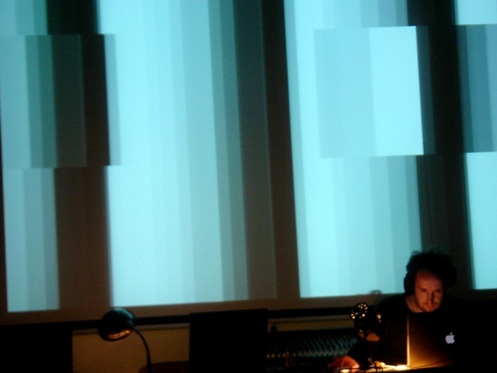
The performance traverses and returns across a radio band, a technological interface, along linear trajectories. Sounds with no correlation between their representation on this band and their ‘actual’ location will be captured, layered, reworked, and transformed within new media to create a cultural and social sonic dérive where all spaces exist simultaneously.
Garrett Lynch (IRL) is an artist, lecturer, curator and theorist. His work deals with networks (in their most open sense) within an artistic context; the spaces between the artist, artworks and audience as a means, site and context for artistic initiation, creation and discourse. Recently most active in live performance, Garrett’s practice covers net.art, installation, performance and writing.
PARKcycle by Rebar Group
The PARKcycle is a human-powered open space distribution system designed for agile movement within the existing auto-centric urban infrastructure.
While its physical dimensions synchronize with the automotive “softscape” of lane stripes and metered stalls, the PARKcycle effectively re-programs the urban hardscape by delivering massive quantities of green open space—up to 4,320 square foot minutes of park per stop—thus temporarily reframing the right-of-way as green space, not just a car space.
Using a plug-and-play approach, the PARKcycle provides open space benefits to neighbourhoods that need it, when they need it, as soon as it is parked.
Built-in collaboration with the kinetic sculptor Ruben Margolin at his studio in Emeryville, California, the PARKcycle made its debut on PARK(ing) Day 2007 in San Francisco.
PARKcycle was made possible by a grant from the Black Rock Arts Foundation.

REBAR is an interdisciplinary art and design studio based in San Francisco. Rebar has created public art interventions and design projects around the globe. Rebar remixes the ordinary repurposes the ubiquitous, and restructures the fabric of the urban environment by exposing hidden assumptions and shared meanings embedded in the everyday experience of the built world.
Virtual Entity by XNAME
Virtual Entity is a research project and net-art work trying to redefine the concepts of authenticity, ownership, uniqueness and seriality within the digital domain. The practical aspect of this speculation is a simple application developed to create (and edit) the soul of a file. This is a metaphor: the soul, a text-based soul, is the place where it is written who or what a certain entity is; it is a mark for preserving identity.
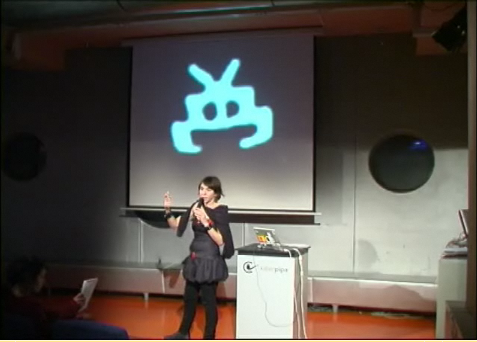
This software, proposing a single answer to the questions raised by the practices of licensing and cataloguing digital files, is transforming the traditional approach towards metadata and digital property. The main idea is that any file is an independent creation living its own life and experiencing various levels of transformation and progressive generation (of meaning, shape, and entities) in the course of its virtual existence. The main focus points are the relations (semantic or genetic) among files and the processes of fragmentation, multiplication and transmutation of the cultural units composing them.
Virtual Entity constructs in parallel a theoretical mythical world and its functional technical counterpart; its ultimate shape (and visualization) is that of a monster, a bodyless entity composed of souls and formed by the structure of their relations – and the history of digital data starts drawing itself.
Virtual Entity is displayed for the first time as an installation at Furtherfield Gallery in London. The work takes the form of a tryptic. The central projection shows the command line application soul, the left monitor displays the web application souls, while the right monitor displays the virtual entity monster, a real-time representation of the database performed by live coding software Fluxus.
Virtual Entity Alpha is prototype software. Its main new features are URL support, macosx install, web application, Fluxus visualisation. This software was designed by xname and coded by xname, megabug, Antonios Galanopoulos and Gabor Papp.
Events at Furtherfield Gallery
Opening event: 25 February 2011, 6.30-9pm
Live Performance by Garrett Lynch at 7.30pm
Special programme by REFF the Fake Institution
Open call to Remix the World! Reinvent Reality
The REFF map on the exhibition is available online from the opening date: http://reff.romaeuropa.org. The mapping process is open: please contact us if you feel that your actions are reinventing reality and, thus, should be added to the visualization. http://www.furtherfield.org/contact
REFF Youth Programme
A special task force was required to ensure the immediate diffusion of the REFF AR Drug to the younger generations. Perhaps surprisingly, the Fake Institution agenda has inspired approval and enthusiasm in the academic world. In the two weeks before the exhibition FakePress, together with Art is Open Source, is running a series of workshops and presentations across universities and to groups of students in and around London to remix the world: Southbank University, Goldsmiths, Writtle College, University of Westminster, Queen Mary University.
Please contact us if you’d like to participate or organise further workshops/presentations http://www.furtherfield.org/contact
More information about student workshops.
Please visit AOS website to learn more about what happened during the REFF workshops
MACME, an open source tool for cross-medial publishing
Created by FakePress, MACME is new a cross-media, multi-author content management system, that enables the creation of multi-device and paper publications, featuring location- based technologies, QR-codes, and augmented reality .
The platform will be released for the first time during the days of the exhibition, under a GPL3 Licence, as a real policy for access promoted by the REFF.
Student movements in Italy/UK
”The use of communication technologies and invasive practices for reinvention reality is crucial for student movements in this difficult moment. We would like to get the students involved in the REFF experiments by providing access to those technologies that can work as effective forms of critical and alternative communication. Students in the UK and in Italy will have access to all the cross-medial CMS used to build the REFF book, which will enable them to create their own QRCodes and Fiducial markers that they can then stick around the city to disseminate information integrated within their communication across the web and the city.” – Art is Open Source.
During the exhibition run, students will also be invited to curate their own event in which they can present their take on the idea of “reinvention of reality”, and connect with the students’ movements in other countries (using Skype at Furtherfield, at the ESC in Rome and at the Cantiere in Milan) presenting themselves to each other. The event will terminate with an urban performance in which each party exchanges and prints QRCodes stickers that are then disseminated across the city.
More about Art is Open Source
AOS operates interdisciplinarily across universities and research institutes, businesses and associations, critical collectives and extreme practitioners in arts and design, promoting innovative approaches to the environment, to (multi)cultural interaction, and to the creation of real, sustainable and socially responsible opportunities.
More about REFF
REFF started by investigating themes around intellectual property and cultural policies and then expanded to the domains of freedom of expression and the idea that the tactical use of technologies and network-oriented practices can enable people to change the rules of the game and reinvent our reality. Taking inspiration from street arts, raves, skateboarding, and technologies allow us to re-code and write onto the world, creating layers of additional reality that express our own interpretation of the cities we live in, of the things we buy and use every day.
One project outcome is a book published in 2010, which will soon be available in English. The book is a cross-medial publication enacting the theories investigated by FakePress (a next-step publishing house created by AOS in 2009 researching the REFF themes through the idea of reinventing publishing itself): it is simultaneously a book; a location-based, augmented reality application; a living digital ecosystem; and a wide tagging mechanism using QRCodes and Fiducial Markers to disseminate content and interactions on objects, architectures and spaces.
The book was created using a series of technological tools to maximise accessibility to these critical tactical technologies. The tools have been arranged into a platform called MACME (Multi Author Cross Medial Ecosystem) that has just been released under a GPL3 licensing scheme. The release of these and further technologies is an integral part of the work of net.art, which informs the REFF project.
For more information:
http://www.artisopensource.net
http://www.romaeuropa.org/
http://www.fakepress.it/
A performance by Alexandre Burton and Julien Roy
Alberta College of Art and Design (ACAD), Calgary, Canada, November 11, 2010
“We are absorbed by the beauty of electronics absorbing into the air,” is how Burton and Roy described their literally electrifying, and often frightening forty-five minute audiovisual performance of high-voltage electromagnetic disturbances. The event necessitated everyone present turning off their cell phones, i-whatever’s, and cameras to avoid provoking 800,000 volts of raw Frankenstein-like crackling electricity from throwing out a surprise lightening bolt and zapping an unsuspecting audience member.
POWEr’s instrument is an audio-modulated Tesla Coil with its own “boutique” ground that resembles a stripped down tuba with lots of copper colored coils. A bent over piece of metal culls the tail end of the generated electricity so it can be captured by a high-speed camera, and processed and re-purposed. Both Burton and Roy, who trained in contemporary classical music training in composition and electro-acoustics at the University of Montreal added, “We like noise so we try not to do melody, except at the end.”
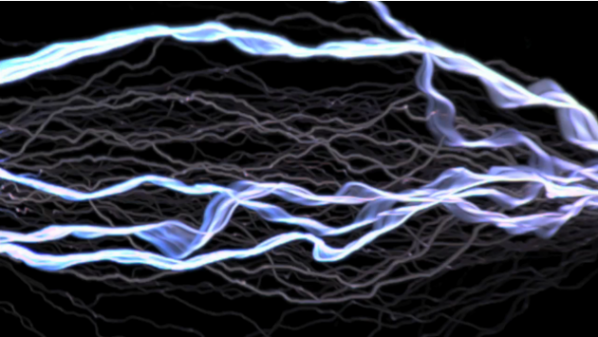
The piece is raw and alive, and no photograph or video can substitute for sitting in the line of fire of a sparking raw electrical feed. It smells tangy and metallic; a by-product of its ozone inducing properties and you can practically taste the microscopic particulate matter its hybrid frisson generates on your tongue. The sheer shock of its taser-like impact up close and personal is mesmerizing and anesthetizing but its actual menace doesn’t lie in its extreme voltage, but in its electrical amps, which is the charge that actually goes through you. “If the amp is low it just goes onto your skin, but if the amp is high you can die,” the artists sanguinely informed the audience in a Q & A after the performance. They also explained it took six months to come up with the idea, and another six months to make he piece not explode.
The creator’s studio site Artificiel.org says they are interested in “the desubjectification of sound and image materials, R&D creativity as the consequence of artistic research and the building of a genuine digital performance practice.” This idea is coupled with an astute technical know-how. To capture such an electrifying event the camera runs in a special “forever mode” that can be wiped clean at their discretion. The electromagnetic arc produced by the Tesla coils lasts for just a few very bright nanoseconds, so using a mechanical shutter is impractical. The ISO, dampened down to 50, allows a baseline sensitivity to actually capture the image.

Once captured, the images are transferred to the computer via a high-speed uncompressed connection, where recording, filtering and geometric adjustments are made. The visual data is handled as sound, allowing quick and precise images to be processed on the fly. “It is also a very intuitive approach to “synesthesia,” Burton said as the software abstracts both sound and visuals in the same way. Logic Pro and MAX/MSP/Jitter manipulate duration, signal, timbre, and resonance live time as technology and geekiness combine with a dash of old style showbiz razzle dazzle to produce a truly hair raising show.
(Images above are excerpts from a performance in Québec city 2010)
View video of Alexandre Burton’s and Julien Roy’s live performance here http://vimeo.com/9816953
On October 10th, 2010, the Upstage Festival of Performance Art (101010) curated by Helen Varley Jamieson, Vicki Smith, and Dan Untitled ran for approximately twenty hours, the fourth such iteration of themed dates (last year ran on 090909.) 101010 showcased thirteen new cyber performances from Canada, USA, UK, France, Germany, Italy, Sweden, Austria, Serbia, Australia, and New Zealand, most lasting for twenty minutes. UpStage was host to ten real world viewing nodes in Calgary, New York, Nantes, Eindhoven, Oslo, Ljubljana, Pancevo, Vietnam, Auckland, and Wellington. Individuals could also tune in from the comforts of their own homes.
UpStage’s audience derives from anywhere one is capable of accessing a web page, and participation does not require the installation of any new software except the ubiquitous Flash Player plug-in. The application sits on a central server, is free and open source, and programmers can add new code and share improvements and new features. Written in Python, UpStage works with third-party applications. It provides a set of tools for logged in players to work with a variety of media in real time; graphics (still images and animations), video (live web cam feeds or prerecorded video), audio (text2speech synthesized speech or prerecorded audio), text and illustrations that are collaboratively manipulated to create an improvised or rehearsed event.

Performers, euphemistically referred to as “players”, show up in the “stage” or screen area as avatars with access to a variety of pre-created backgrounds and props. When the avatars speak their words appear on-screen as a cartoon-like bubble, and their speech is simultaneously rendered in the odd robotic text2speech function. The thirteen performances were grouped into four themed categories. Temporal explored sound and movement across time and networks. Trajectory examined the path of a moving object through space, and the arc where that object intersected with the story. Tendrils wove subtle thoughts and concepts, and Transgress went beyond limits to question, challenge, and provoke.
MIT Professor Sherry Turkel in her 1995 groundbreaking book Life On The Screen first codified the anonymous audience interaction. UpStage’s appeal is its live-time interactivity that emulates the anonymity of sites like Second Life, but also employs scripted dramas that let the audience (either all of the time, or at selected moments) jump into the story. It raises the question of the difference between “stage” acting in a traditional theater, and acting in front of a virtual audience, an issue bridged by maintaining traditional chat function.
Before a scheduled performance begins, one can congregate in a virtual foyer and facilitators use a megaphone to speak in synthesized robotic text2speech voices. A second screen tab hosts the site of the virtual performance area. Depending on whom Upstage is trying to connect with, the dialogue and effects can flow swiftly, or be disrupted.

I was able to view four performances over the span of two hours. “Plaice or Sole” by Francesco Buonaiuto, Mario Ferrigno, and Simona Cipollaro (Naples) contained graphic sexual content that was presented in a purposely immature style. At first it was annoying and boring, but afterwards I was informed that was the point – to emulate and call attention to the inane comments and dialog that occur in many on-line cybersex chat rooms. A crash during the site’s interaction was a deliberate simulation of a technical failure. As one person put it, “it forced you to become engaged in the text shift.”

Active Layers, is a virtual collective includes Cherry Truluck (UK), Liz Bryce (NZ), James Cunningham and Suzon Fuks (Australia). They combine theatre, dance, video and visual arts both digitally and conceptually to redefine the meaning of location and site. Their animation piece “Aquifer Fountain” focused on drought, water, flooding, and devastation, with mothers dreaming of lost babies. During the performance the actors participated from London, Kawerau and Milwaukee.
“Make Shift” is a work in progress by Paula Crutchlow (UK) and Helen Varley Jamieson (NZ/Germany). They used the Upstage audio-visual conferencing tools in two deliberate domestic spaces to link their cyberformances, thus creating a third discursive space. The discussions focused on the political aspects of domesticity such as “nesting, feeding and mobility,” and how this relates to the experience of globalization.
“MASS-MESS ” by Katarina DJ. Urosevic & Jelena Lalic (Serbia) ran both virtually and at the physical node at Galerija Elektrika in Pancevo. It was a study of structures, mass media and independence in the context of a hierarchy of information without a center playing out like a post-Soviet Politburo manifesto. “MASS-MESS” made it onto Serbian TV, as evinced by a subsequent newscast posted onto YouTube.
Above image taken by Scott Beale, Laughing Squid.
Marc Da Costa interviews the ever dynamic Johannes Grenzfurthner, founder of monochrom. This is the first of three interviews, where he talks about the project ‘Soviet Unterzoegersdorf’; the fake history of the “last existing appanage republic of the USSR”. Created to discuss topics such as the theoretical problems of historiography, the concept of the “socialist utopia” and the political struggles of postwar Europe. In March 2009 Monochrom presented ‘Soviet Unterzoegersdorf: Sector II’. The game features special guest appearances of Cory Doctorow, Bruce Sterling, Jello Biafra, Jason Scott, Bre Pettis and MC Frontalot.
Since 1993, the Monochrom members have devoted themselves to the grey zones where systems intersect: the art (market), politics, economics, pop, gaiety, vanity, good clean fanaticism, crisis, language, culture, self-content, identity, utopia, mania and despair. The technique underlying Monochrom’s work is that of being and working in the fields of Pop/avant-garde, theory/reflection, interventionism/politics, gaiety/lust/tragedy, (self-)configuration/mystification. The project Monochrom pushes into and beyond these fields is, ‘networking’ events, people, possibilities, material, impetus and identities.” (Zdenka Badovinac, Moderna Galerija Ljubljana)
Grenzfurthner has collaborated with groups such as ubermorgen, Billboard Liberation Front, Esel and Mego (label). Grenzfurthner writes for various online/print magazines and radio stations (e.g. ORF, Telepolis, Boing Boing). Grenzfurthner has served on a number of art juries (e.g. Steirischer Herbst, Graz). He holds a professorship for art theory and art practice at the University of Applied Sciences, Graz, Austria and is a lecturer at University of Arts and Industrial Design in Linz, Austria.
Recurring topics in Johannes Grenzfurthner’s artistic and textual work are: contemporary art, activism, performance, humour, philosophy, sex, communism, postmodernism, media theory, cultural studies, popular culture studies, science fiction, and the debate about copyright.
The ‘Soviet Unterzoegersdorf’, a game created by monochrom, is described as being at once the “last existing appendage republic of the USSR” and located inside the Republic of Austria. Could you speak a bit about the project and its background?
From a conceptual background we have to state that we have been occupied with the construction, analysis and reflection of alternative worlds for quite a long time. A lot of our projects are treating this field partly as a discussion with concepts deriving from popular culture, science and philosophy, and partly as a direct reference to science fiction and fantasy fan culture. We first created the fake history of the “last existing appendage republic of the USSR” in 2001 — ten years after the ‘mighty Soviet Union’ went into this nation-state-splitting-up-process and new countries emerged like Firefox pop-ups that you can’t manage to click away.
We wanted to discuss topics such as the problems of historiography, the concept of “utopia” and “socialist utopia” and the political struggles of postwar Europe in a playful, grotesque way. You have to bear in mind that the real village of Unterzoegersdorf was part of the Post WWII Soviet zone from 1945 until the foundation of the ‘neutral’ Republic of Austria in 1955. Reactionary Austrians talk about 1955 as the ‘real liberation’… and I have to mention that that’s rather typical: cheering when Hitler arrives and being proud members of the Third Reich, afterwards proclaiming that Austria was the first victim of Nazi Germany and complaining about the allied occupation forces — especially the Soviet.
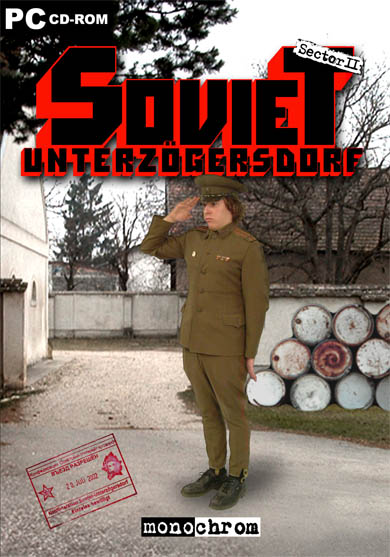
We transformed the theoretical concept into an improvisational theatre/performance/live action role-playing game that lasted two days. That means we really organized bus tours to Unterzoegersdorf — a small village that really exists — and acted the setting; beginning with the harsh EU Schengen border control. Later, in 2004, we started to think about a possible sequel to the performance. We thought that the cultural format of the “adventure game” provided the perfect media platform to communicate and improve the idea.
We started to work in February 2004 and presented ‘Sector 1’ — the first part of the trilogy — in the form of an exhibition in Graz/Austria in August 2005. We released ‘Sector 2’ in 2009, featuring guest stars as Cory Doctorow, Jello Biafra or Bruce Sterling. As the game series uses a 3rd person perspective with photo backgrounds and pictures of real actors as sprites, it took us quite a while to digitize and image process all of the material. This technique was actually first used by Sierra On-Line during the early and mid-1990s — but we are quite proud that we managed to get the feeling of discovering an old computer game that never existed on your old 500 MB hard drive. One aspect of the game is playing with memories and the future of the past. The future is a kind of carrot, the sort tied just in front of the cartoon donkey’s nose so it goes to work, goes off to war, learns Javascript and knows which bits to laugh at in Woody Allen’s Sleeper. You can imagine.
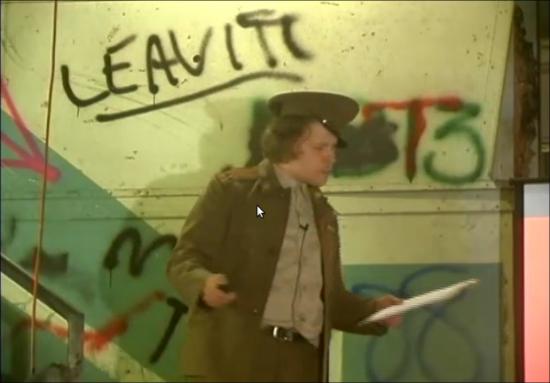
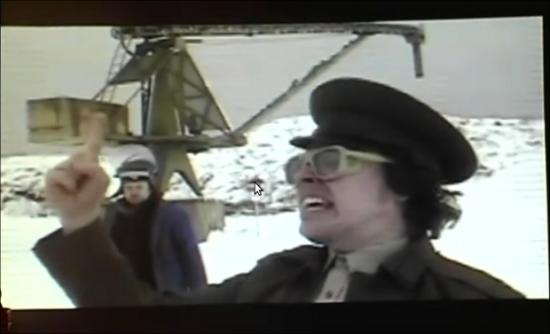
At a HOPE conference a few years back I was interested to hear you talk about the framing of the project as somehow deeply connected with a certain understanding of historiography that you and the other members of monochrom share. Could you elaborate on this a bit?
Debates triggered by postmodern culture have directed our attention towards questions of representation and the relevance of “history” and stories — i.e. The challenging proclamation of a post-histoire, the realization of the impossibility of a meta-narrative of history; the clash between reality and sign systems, the difference between fact and fiction, the impossibility of neutral contemplation or witnessing as well as the positioning of subjective awareness within such representations, etc. All these forms of representation have been playing a central part in the development of national, ethnic and tribal identities since WWII. And (as a by-product of military technology) computer game development is hardly aware of these discourses.
We wanted to combine (retro)gaming and (retro)politics and (crypto)humor to delve into this ongoing discourse. We wanted to harvest the wonderful aesthetic and historic qualities of adventure gaming. It is a commemoration and resurrection, and one more reminder that contemporary gaming (in its radical business-driven state-of-the-artness) should not dare to forget the (un)dead media of the past — or they will haunt them.
If you compare the status of the adventure game in the context of the economic growth of the computer game industry you could state that it is gone. Less than 1% of all computer games written are adventure games. Adventure games are nearly extinct… but only nearly. If media and media applications make it past their Golden Vaporware stage, they usually expand like giant fungi and then shrink back to some protective niche. They just all jostle around seeking a more perfect app.
For many people in the Soviet Unterzoegersdorf team, adventure games are part of their media socialization. For the computer industry it is one of the most successful gaming formats of the past. And for the feminist movement it is proof that a woman — I’m talking about Sierra On-Line’s Roberta Williams — was able to shape the form of a whole industry totally dominated by men.
Computer games are embedded in the cultural framework of technological developments. In the study of technological development and creativity, focusing attention on the failure, the error, the breakdown, the malfunction means opening the black box of technology. Studies have convincingly demonstrated that the widespread inability to understand technological artifacts as fabricated entities, as social and cultural phenomena, derives from the fact that in retrospect only those technologies that prove functional for a culture and can be integrated into everyday life are “left over.” However, the perception of what is functional, successful and useful is itself the product of social and cultural–and last but not least–political and economic processes. Selection processes and abandoned products and product forms are usually not discussed. According to Langdon Winner, there is a sense in which all technical activity contains an inherent tendency toward forgetfulness. Quote: “Is it not the point of all invention, technique, apparatus, and organization to have something and have it over with? (…) Technology, then allows us to ignore our own works. It is license to forget.”
Could you also perhaps talk about the choice of selecting the genre of an adventure game as the incarnation of this downtrodden republic. At the risk of being literal minded, is there any sense in which the existence of ‘Soviet Unterzoegersdorf’ as a kind of place that comes alive through players’ interactions with a program downloaded from the internet has anything to say to how you imagine being able to engage/critique/disrupt the idea of the nation-state?
We are postmodern leftists. A little bit melancholic… but you can count on us. We love to play with layers of consciousness and layers of layers of consciousness. On first view our project could be interpreted as a mock-up of the Soviet Union and the communist state structures that really existed. But, why on Earth do we need so many references to 1980s and 1990s metal music? Or Marvin Minsky? Or Negri? Or Austrian post-WWII history? Or geek adumbrations? Mocking the Soviet State would be much easier. In fact it’s about the wonderful clash between reality and sign systems, the impossibility of neutral contemplation or witnessing as well as the positioning of subjective awareness within such representations. The traditional humanists tend to see the whole philosophic aesthetic postmodern line of thought — from Judith Butler to Lyotard and Derrida — from the wrong angle. Okay, you can’t explain Sun Ra to a Green Day fan now, when he’s laying in the corner, piss-drunk and crooning “Anarchy”. But we think that the (radical) nature of postmodernism is often simply not grasped because people just copy it down into the conservative pattern of thinking which has been indoctrinated into us since the Enlightenment. Of course, on the other hand, it functions as a virus, and there’s nothing wrong with that.
Contemporary art — the field we are usually working in because there’s money — is mostly concerned with systems or systematic concepts. In the context of their work, artists adapt models of individual art-specific or economic or political systems like in a laboratory, to reveal the true nature of these systems by deconstructing them. So would it be fair to say that by their chameleon-like adaptation they are attempting to generate a similar system? Well… the corporate change in the art market has aged somewhat in the meantime and looks almost as old as the ‘New Economy’. Now even the last snotty brat has realized that all the hogwash about the creative industries, sponsoring, fund-raising, the whole load of bullshit about the beautiful new art enterprises, was not much more than the awful veneer on the stupid, crass fanfare of neo-liberal liberation teleology. What is the truth behind the shifting spheres of activity between computer graphics, web design and the rest of all those frequency-orientated nerd pursuits? A lonely business with other lonely people at their terminals. And in the meantime the other part of the corporate identity has incidentally wasted whole countries like Argentina or Iceland. That’s the real truth of the matter.
Read Part 2 of this Interview
http://www.furtherfield.org/features/interviews/interview-johannes-grenzfurthner-monochrom-part-2
Read Part 3 of this Interview
http://www.furtherfield.org/features/interviews/interview-johannes-grenzfurthner-monochrom-part-3
HTTP Gallery is pleased to host LAB4 by Hedva Eltanani, an exploration of communication between two places using streaming media and web applications. It is another step in a series of LABs that explore digital technology and audience interaction. It is part of Heltanani’s research on digital performance and the way it affects audience experience.
LAB4 is a game that challenges the audience to bend the boundaries of space, interaction and intimacy. The two locations, HTTP Gallery in London and The Poly Centre in Falmouth, are linked via live-feed technology, using webcams and web applications. Eltanani will lead a series of activities, such as ‘truth or dare’, which challenges elements of group dynamics and technology – the aim is to engage the two audiences and help participants bond within each group.
How intimate will it go? The participants are invited to deepen the connection by keeping their community active using web applications.
BE PART OF THE EVENT IN LONDON
Doors open at 8:30pm
More info and documentation :
http://arthubfalmouth.blogspot.com/
http://vs4rslab.wordpress.com/
Featured image: People watching and being watched across virtual space
Helen Varley Jamieson and Paula Crutchlow will be working as Artists in Residence at HTTP, Furtherfield’s Gallery and lab space in July 2010. During this residency Helen and Paula will work on their make-shift project.
Events related to this residency:
make-shift presentation by the artists at HTTP Gallery, 22 July 2010.
More information about this work in progress presentation.
“make-shift is an intimate and participatory performance event that explores the fragile connectivity of human and ecological relationships. Part recital, part discursive salon the performance uses online audio-visual conferencing, chat and performance tools to connect two ordinary living-rooms and their audiences across geographical and cultural distance.”
http://make-shift.net/
Helen Varley Jamieson is a writer, theatre practitioner and digital artist from New Zealand. In 2008 she completed a Master of Arts (research) at Queensland University of Technology (Australia) investigating her practice of cyberformance – live performance on the internet – which she has been developing for over a decade. She is a founding member of the globally-dispersed cyberformance troupe Avatar Body Collision, and the project manager of UpStage, an open source web-based platform for cyberformance. Using UpStage, she has co-curated online festivals involving artists and audiences around the world. Helen is also the “web queen” of the Magdalena Project, an international network of women in contemporary theatre.
www.creative-catalyst.com
Paula Crutchlow lives with her family in Exeter, Devon. She graduated in Dance from De Montfort University, and in 2000 completed an MA in Devised Theatre at Dartington College of Arts, UK where she is now an Associate Lecturer in Theatre. Paula has worked in Britain and internationally as a performer, director and tutor of movement and devised theatre. As a co-founder and Artistic Director of Blind Ditch she has collaborated on context-specific collaborative art, performance and cultural events which engage audiences and participants in distinct ways through the use of digital media and live performance.
www.blindditch.org
>> make-shift work in progress presentation by Helen Varley Jamieson and Paula Crutchlow
Thursday 22nd July 7pm
HTTP Gallery
RSVP: brokers@make-shift.net
You are invited to attend and actively contribute to a work in process sharing of make-shift – a networked performance about connectivity and consequences.
Helen Varley Jamieson (NZ/Europe) and Paula Crutchlow (UK) are artists from different performance backgrounds whose new collaboration, make-shift, explores meaningful ways of engaging in discussion across physical and digital networks. make-shift will be a salon-style event, taking place simultaneously in two domestic spaces (with one artist present in each space) and also online.
The process of making make-shift has begun with a two-week residency at Furtherfield.org, London, and in this presentation the artists would like to share some of their research and try out some ideas. You will be asked questions and invited to contribute your expertise, experience and opinions to this process. The artists are working in the spaces between disciplines and genres and are deliberately inviting people from a range fields to get a range of input. Your contribution to this will be very much valued.
You must RSVP (to brokers@make-shift.net) as the proximal audience is limited (there will also be the opportunity to participate online if you are not in London or can’t get to the event). Everyone who is attending is asked to collect their plastic rubbish over a 24 hour period and bring it to the presentation (please wash anything that had food in it!)
We also need two volunteers to prepare specific tasks before the event – please email brokers@make-shift.net if you would like to volunteer.
Playing Hard: Urban Art Games of Summer 2010.
Not long ago, urban games were a kind of novelty. Some grew out of the street performance tradition of live theater. Some came from gamers who were involved in tabletop RPG and wanted to experiment with live reenactment. Others were produced by media artists as a way of experimenting with new technologies like GPS and text messaging. But along with these approaches to play, and at times learning from their carefree attitude towards entertainment, there grew another tradition of the urban game, a tradition of using the city focusing on exploration, and as a specific kind of critique. At its worst, the artist produced street game replicates of hollow self-promotion, through corporate, sponsored seasonal festivals. But just as experimental art can involve an analysis of mainstream art, the urban game can embody a palatable critique of the routines of city systems, including the deadening routines of metropolitan life and some of the large scale mechanisms of corporate capitalism.
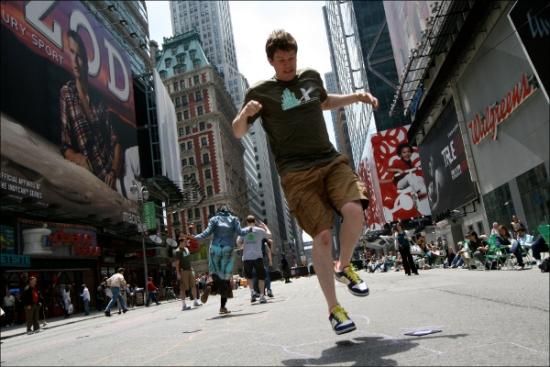
These kinds of games echo the spirit of the Situationist International, which called on artists to create alternate experiences through the construction of situations, psychogeography, and the use of play as a form of critical thinking. Urban games can also remind us of Hakim Bey and his idea of a Temporary Autonomous Zone by using goals, rules, and play with the creation of the ‘magic circle’, a world inside a world, as a method of directing public imagination towards an alternative presence, a way of acting and existing as an independent community within a larger, more repressive reality, even if only momentarily. Urban games also continue the Fluxus idea of the ‘happening’, a participatory media form in which audiences support artists, moving beyond the role of observers of performance to become collaborators in events. With the urban games season about to begin, this review takes a look at how several groups, either consciously or at times not so consciously, have interpreted these traditions for summer 2010.
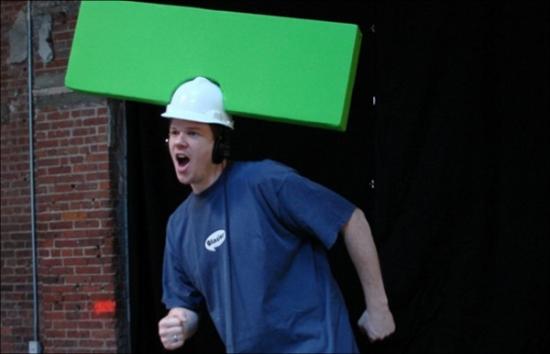
In New York, the much loved Come Out and Play Festival will run from June 4th through June 6th, with events scattered throughout the city borough of Brooklyn. Games include playground mods, GPS exploits, extreme sports, narrative quests, and massively multiplayer scavenger hunts. The festival hosts about forty game designers from around the world and about two thousand people will attend. Executive producer Greg Trefry says COaP strives to be entertaining and is not so much concerned with philosophy as it is with place: “Where the festival is located each year is actually really important to us. We look for interesting parts of the city to experiment on and use as the stage for the festival. So we’ve played everywhere from big anonymous urban areas like Times Square to now more family oriented locales like Park Slope.”
Still, the designers of COaP seem to have a way of engulfing serious issues with comedy and encouraging people reclaim neglected parts of the city by giving them a second look. Along these lines, Atmosphere Industries of Toronto will present Gentrification, a game that picks up on Brooklyn’s ongoing housing conflicts by asking players to assume the roles of real estate developers or neighborhood locals while collecting properties and gentrifying neighborhoods. Meanwhile, Gnarwhal Studios of Baltimore will sponsor ‘Humans vs. Zombies’, a modification of the playground game tag that introduces large groups of strangers to one another by sending players out into the city as the walking dead.. It’s hard to sit in a park, completely shut off from everyone around you, during a two hundred person simulation of a zombie attack. Also part of COaP, New York’s Crux Club will confront community fears of toxic contamination through their game ‘It Lurks in Gowanus’, a hide-and-seek mod that asks participants to track down a creature who has ominously escaped from legendary pollution of the neighborhood’s Gowanus Canal.
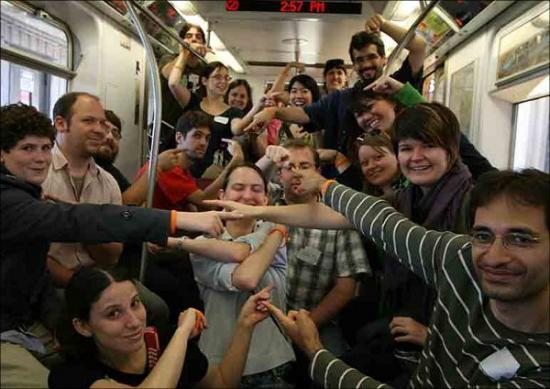
Although he agrees that all urban game events take some kind of cue from historical antecedents like the Situationist International or Fluxus, producer Trefry resists making a formal connection between these movements and COaP. Instead, he says, the main concern was and continues to be community building, getting people together in a surprising way and in an unexpected space: “At its heart, the festival is about running around outside and having fun with your friends. It sounds silly, but that’s such an amazing thing to experience.” This goal of community building has caused COaP to inspire other urban games festivals, including the Hide & Seek Festival in London and the igFest in Bristol, and the Steel City Games Fest in Pittsburgh. The organized versus the random, or the juxtaposition of the carefully designed structure of a game with the largely unstructured, seemingly arbitrary activity of ordinary public space continues to be a common interest among COaP design groups, which are likely to include engineers, academics, and urban planners alongside artists and actors.
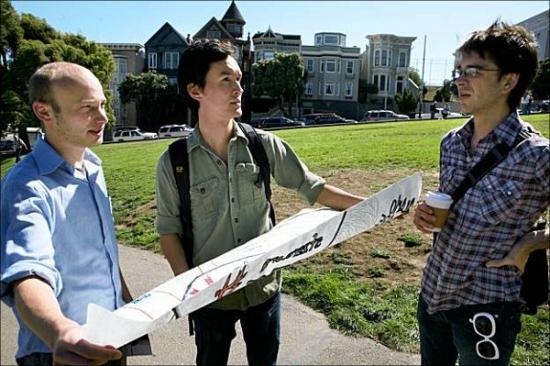
In San Francisco, the artists of SFZero cite Situationism and Fluxus as fundamental to their practice. The SFZero collective was founded by Ian Kizu-Blair, Sam Lavigne, and Sean Mahan in January 2006. Initially, the group used something like a Fluxus process of writing instructions for happening-like events that teams of other players acted out. Soon, these collaborations became the basis for both an online community and real world urban games network that now include over five thousand players. Through the SFZero website, participants initiate events by challenging other participants to ‘Eat a food that frightens you’, or ‘Go to a street corner of your choosing and wait for something fantastic to happen.’ SFZero seems to agree with classic Situationist objectives. A good game shifts awareness, Kizu-Blair says, changing the city for the people who play: ‘Oftentimes the players report that they have a completely different experience of the urban environment as a result of playing and go to places in their city where they have never been before. There is a cinematic quality whereby players live out experiences that normally exist only in spy movies – chases down dark alleys, chance meetings, etc.’ Typical SFZero tasks range from exploring overlooked locations in the city to taking a chance on meeting new people.
As fantastic as some of these instructions sound, and as important as the Internet is to SFZero’s success, Kizu-Blair says it is essential that some productions have a real world component: ‘As people become disenchanted with eight plus hours per day of screen time, they are increasingly gravitating towards hybrid activities that bridge the space between the virtual imaginary and the physical real world. These activities blend the safety and simple pleasure of screens with the risk, tension and excitement of physical interaction. More and more, members of our society will seek to escape from escapism towards an ethics of action, to escape from movies to real experiences. They will find that they have little idea how to have real experiences after their time in the imaginary. SFZero is the transition. ‘SFZero offers both real-world excitement and eternal return to the screen, to re-live, re-experience and re-imagine your engagement with reality.’
Recently, Kizu-Blair, Lavigne, and Mahan have begun staging riskier, more elaborate game events like ‘Journey To the End Of Night’, in which runners try to make it through six checkpoints on foot or by public transportation, while avoiding capture by chasers. An early version of Journey actually opened the 2006 season of Come Out and Play. This July, the veteran SFZero player Lincoln will stage a further production of Journey in Los Angeles.
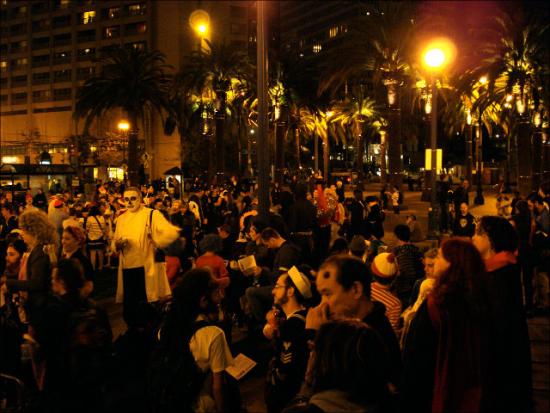
This summer, SFZero will present The Wanderers Union, a game that is loosely based on a French style of self-supported long-distance cycling called randonneuring. To perform Wanderers Union, players get a set amount of time to travel on foot and by public transportation through a series of zones. The idea is to create a single holistic experience of a urban area. The journey intends to juxtapose city spaces in ways that reveal meanings that might otherwise remain unobserved. Players who complete all of the events will progress from an initial four hour wandering to a final twenty-four hour wandering. By using play as a means of gaining understanding, participants will hopefully gain a small degree of mastery over urban space. Kizu-Blair says: ‘It’s like a video game – you level up and gain powers – but you have the added satisfaction of doing something real, and you can include anyone in the experience.’
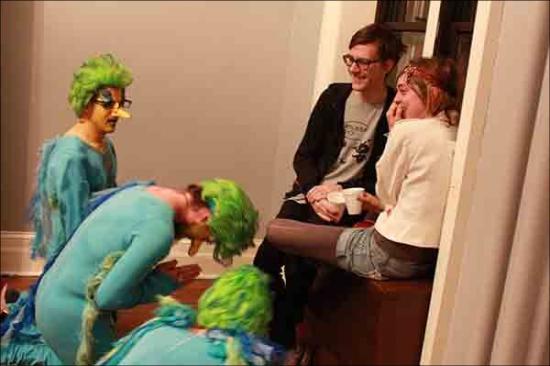
Back on the East coast, the New York based artist’s collective Opt-In found that what started as a thesis project for an experimental film class unexpectedly became a series of multimedia events that now includes filmmakers, fine artists, dancers, performers, and musicians. Titled ‘ZeroDay Exploits’, these evenings are the work of Bryn Jackson, Sarah Lerner, and Nathaniel Barker, who says the group has adapted the Fluxus concept of “happening” to the 21st century: ‘We create immersive environments in which strangers and friends can form new communities around a project, an idea, or a simple good time. We bring people from all walks of life together by promoting open dialogue and the creative expression of public discourse through a vast array of mediums and the use of public space.’
Past themes for the Opt-In exploits have included faith and technology. This July, the group plans to explore the idea of “home” by inviting guest artists and guests to contribute items and materials that evoke a sensation of home. The goal of this event is to create a sense of rootedness in New York, a city of perpetual resettlement. Another major goal for Opt-In is the deconstruction of the digital experience through live performance. According to Barker: ‘Our focus has always been on participation, so our events offer multiple means for encouraging visitors to get their hands dirty including music, secret actors to stimulate conversation, inclusive performances, and free art materials for spontaneous art creation.’
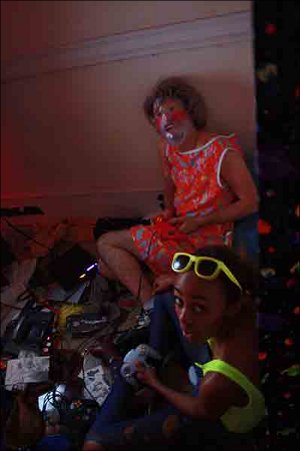
Also related to Fluxus, but in a gesture that seems more directed towards the Brazilian director Augusto Boal, a group calling themselves Invisible Playground Berlin, uses the urban game as a kind of political visualization. Founded by the artist known as Sebastian Quack Sebastian, this group’s interests lie at the intersection of theater and digital gaming. In ‘F Be I, See I A’, Invisible Playground re-enacted peer-to-peer communication as a giant game of urban capture the flag. Later, in Space Station Escape, the group simulated the release of an alien virus inside a phantom space station supposedly docked underground beneath Alexanderplatz.
Sebastian views missions and rule sets as ‘experience systems’, Games are a kind of participatory appropriation, an interrogative code that is placed over or enacted within an existing urban mechanism. In other words, if you want to get people to think more critically about the way immigration works in your city, you’d design a game that plays with the existing locations, activities, and mechanisms of immigration. In this way, Invisible Playground intends to put forward what otherwise goes unnoticed, tolerated, or is even passively accepted. Sebastian is careful to structure his rule sets in ways that highlight the power structures that arise between groups of players, between players and their environments, or between players and organizers. According to the Schwellenland site: ‘Players must work together and against each other. Over SMS and email you are guided to appointments and arrive at places where you were barred from entry until now. The game asks you to decipher who is legal, who is questionable, who can be trusted, who will trust you, who observes you, what should be ignored, what is critical. You are accompanied by a coach and by referees who left the usual national borders behind long ago and are now in Vienna as refugees without papers. These specialists can help you to master the challenges of being from a developing country. But they have also power to turn on you if you make too many errors.’

Finally, with a practice based in both New York and in Brazil, Adriana Varella is one of the artists behind the AnarkoArtLab, a collective of new-media, visual, dancers and genre benders in residence at the Living Theatre. Each month, Anarko creates a multimedia event that runs as part lab, part performance. This summer, the group plans to become mobile and to bring the Lab to different situations and neighborhoods. ‘We are searching,’ Varella says ‘for a last trace of that most ephemeral and elusive state where only a dusty dystopian haunting may yet remain. ‘Of course,’ Varella says, ‘all of them, Dada, the Situationists, Fluxus they are all our ancestors.’
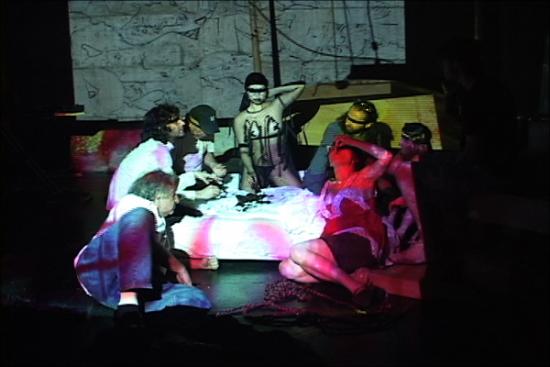
Featured image: Annie Abrahams creates an Internet of feeling – of agitation, collusion, ardour and apprehension.
This essay accompanies If not you not me, an exhibition of networked performance art by Annie Abrahams at HTTP Gallery in London. Where social networking sites make us think of communication as clean and transparent, Abrahams creates an Internet of feeling – of agitation, collusion, ardour and apprehension. This exhibition presents three new collaborative works alongside documentation of recent networked performances created and curated by the artist.
2002. My expectations and behaviour have been shaped by years of work and play at my personal computer. I have habitually ignored my hunched body whilst my attention is projected through key-stroke and mouse click into a social space made of people, digital technologies and the cables, hubs and protocols of the global network.
separation/séparation: A click on a blank web page, displayed in a tall, thin browser window, is like a poke at the body of a sleeping animal. “Do something then!” On the first two clicks, the words “lonely soul” appear in a standard font at the top of the screen. More clicking calls up the following words “…not knowing how to differentiate between you and me, you don’t feel my pain…” Accelerated mouse taps provoke an imperious message on a new screen. “You don’t have the right attitude in front of your computer, either you clic (sic) too fast or with too much force…” With more measured interaction I am allowed to continue with the soliloquy, interspersed with instructions drawn from Workpace, an exercise programme used to assist in the recovery and prevention of Repetitive Strain Injury. The first illustrates a facial work-out. An animated download bar sets the duration of the exercise. I wrangle with the regimen to find a way to skip the prescribed exercises, to get to the end of the story. Finally I comply, performing the therapeutic stretches by the light of my machine. In my imagination other viewers/participants, located around the world in their various domestic settings, are roused from their physical inertia, illuminated by their PCs, in animated, undulating fleshy frills at the edges of the Internet. Returning to the screen for the next chapter, one gentle click at a time, a story of unrequited love unfolds; between an implacable machine and a human-being laid low by their own computer-inspired dreams of control and unlimited power.
This is the first time that my body has been directly addressed, indeed disciplined, by a Net Art work. This is made possible by its complex composition. separation/séparation is made of many parts: a web interface, an economical visual aesthetic, texts (the monologue, the instructions, the commands), human-to-machine interaction. Most of these ingredients are also active in the real-time installations and documentary videos exhibited seven years later in If not you not me at HTTP Gallery. The addition of human-to-human interaction, physical space and objects produces ever more complexity in the structure of the work. However while its many different parts often remain visible, separate and present for the viewer/participant, the effect is not one of disconnected components. Abrahams continues to connect them with the sociality of viewers/participants, generating powerful, singular, artistic affects. More recently her favoured vehicle for artistic exploration is collaboration without which there is no relationship: no me, no you, no other and therefore no artwork. If not you not me asks visitors to explore how relations constitute identity and consider the corporeal implications of an emerging human sociality mediated by complex digital networks.
In 2007 One the Puppet of the Other/ L’un la poupée de L’autre explored the experience of solitude on the Internet while straddling both physical and virtual public space. In this collaborative telematic performance at the Pompidou Centre, Paris, Abrahams and co-author Nicolas Frespech each sat in an igloo tents on stage. Their shadows could be seen moving about within, and who communicated via a system of webcams and microphones. They improvised according to a simple rule where each had to respond to the other’s instructions – “sing a song” or “say something sweet” – to make each the living doll or avatar of the other. The webcam images and amplified conversations were streamed into the auditorium and displayed on a simple double screen projection above the tents. The hazy, flesh-tones of the webcam images had a unifying effect giving the impression of a shared dream. At the same time their physical proximity on stage reemphasised the way in which they were separated by their attempts to control and resist each other as they chose whether or not, as Abrahams writes, “to give flesh to the projections of the other.”
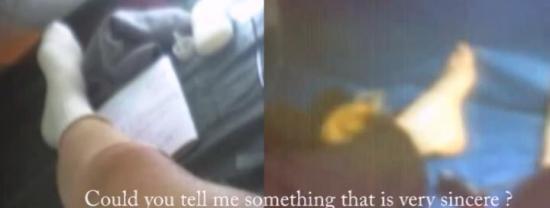
The artists collaborated to negotiate the co-evolution of both a relationship and a performance. This was the first of Abrahams’s networked performances that scrutinised real-time intersubjectivity. More recent works in this area include The Big Kiss with Mark River and Double Blind (Love) co-authored with Curt Cloninger. Distinct from pointing and clicking to control a machine or a game, performers adopt the more complex and subtle rituals and tuning-in techniques of improvising musicians and lovers. This requires them to acknowledge the similarities and differences in the nature of the sentient-other and to accept the other’s autonomy. Unlike Paul Sermon’s reassuring installations such as Telematic Dreaming that invite participants to cooperate within familiar and intimate domestic spaces connected by videostreams, Abrahams’s stark interfaces amplify the performers’ awareness of their solitude. They are alone in their physical space and yet they are responsible for co-constructing an image or a soundscape to express their experience of a relationship with a distant other. The unexpected result for the viewing public can be a disconcerting impression of intense intimacy. Viewers (as voyeurs) witness the emergence of boundaries as they are made and remade in the co-creation of the performance – each piece is a dynamic double portrait of every negotiation, every partnership.
Abrahams’s fascination with collaboration and participation means that she has a strongly developed sense of the context for artwork (not uncommon with artists who work with the Internet – think Jess Loseby’s Digital Kitchen, Andy Deck’s Panel Junction, Avatar Body Collision’s Upstage). She understands the many subtle ways in which curatorial and technical infrastructures impact on the meaning of the work and others’ experience of it. She knows that in order to best familiarise herself with the mechanics and affects of collaboration she has to move through all positions from initiator and director, to participant, to viewer. Her two series of curated performances Breaking Solitude and Double Bind (which she created with technical partner Clement Charmet and Panoplie.org) are remarkable in that they demonstrate the power of a simple interface, a curatorial frame and an extended community of artists experimenting across networks. Breaking Solitude was simply set up as “Web-meetings of about twenty minutes long using chat and streaming to experiment (sic) new ways of being together.” For Double Bind Abrahams creates a more focused context based in her own earlier experiences as a biologist, where she came across the concept of the Double Bind; “a situation with no exit, whatever one chooses one looses [which] leads to illogical, inhibited, ambivalent and misplaced behaviour. Double bind is the result of conflicting cues about a particular situation. An animal that cannot decide between attack and flight is going to eat or scratch.” For this series she asked six artists to reflect on whether double bind describes our relation to technology, within a double webcam performance which could be viewed online and commentated on by up to thirty visitors within a simple message window. Abraham asks: “Is our relation to the computer and internet double bind, bound, bond?…Remote presence, ubiquity, multiple personality, absence of the body? Does this make us schizophrenic? How do we adapt?”
We are unaccustomed to experiencing either art or online social interaction in this way. Most artworks do not require us to participate with so many aspects of ourselves. Most social media interfaces are designed to smooth out the disconcerting glitches and vacuums created by the inevitable interruptions in data-flow. They aim at transparency to give an impression of irrepressible and unproblematic social exchange – as if the last thing we should be aware of when “using” technology is its impact on our physical and psychological well-being. On the one hand this transparency creates an exciting speed of exchange and a froth of production. On the other, however, the bandwidth of our communication is eroded and along with it the range of things that might be conveyed and relations evolved. If it can’t be said in 140 characters, it can’t be said. A voice disappears – no-one notices; the babbling stream of confabulation bypasses, drowns out – bleaches out – absences and depressions. With these ubiquitous interfaces we interact less with other people than with the social utility itself and with our ideas of ourselves.
Abrahams’s work always invites us to acknowledge, feel and imagine in our interactions the many aspects of the machine and the other human being speaking through it. Her current artistic research project Huis Clos / No Exit directly addresses how each person will react in a context of collaboration, at the same time as studying its technical and formal limits and possibilities. Her work’s place in the proliferating network of machines and human-beings (their emotions, desires, even their hormones) makes us aware of the artwork’s simultaneous openness and resistance to our contribution. It encourages us to bring our whole selves to the question of the part we play in the co-evolution of future relations.
Annie Abrahams was born to a farming family in a rural village in the Netherlands. She obtained a doctorate in biology in 1978 and found that her observations of monkeys inspired curiosity about human interactions. After leaving an academic post, she trained as an artist and moved to France, where she became interested in using computers to construct and document her painting installations. She began experimenting with networked performance and making art for the Internet in the mid 1990s. Her work has since returned to the questions raised by the monkeys, concentrating on the possibilities and limitations of communication on the Internet. She has performed and shown work extensively in France, including at the Pompidou Centre, Paris, and in many international galleries including among others Espai d’Art Contemporani de Castello, Spain; the Museum of Contemporary Art, Tokyo; and the Armenian Center for Contemporary Experimental Art, Yerevan; festivals such as the Moscow Film Festival and the International Film Festival of Rotterdam, and on online platforms such as Rhizome.org and Turbulence.
Annie Abrahams will be working as an Artist in Residence at HTTP Gallery in January 2010. During the residency Abrahams will work on the production of three new works including live telematic and online networked performances to be presented as part of If not you not me at HTTP Gallery in February 2010.
Annie Abrahams (b. NL 1954, lives and works FR) is an internationally regarded pioneer of networked performance art. If not you not me at HTTP Gallery in London was the first solo exhibition of her work in the UK. While social networking sites make us think of communication as clean and transparent, Annie Abrahams creates an Internet of feeling – of agitation, collusion, ardour and apprehension.
The residency and exhibition are conceived in connection with Furtherfield’s Rich Networking project interrogating the transparency of communication, artistic collaboration and sociability through digital networks; and as part of Furtherfield’s three-year Media Art Ecologies programme which foregrounds practices sharing an ecological approach – an interest in the interrelation of technological and natural processes: beings and things, individuals and multitudes, matter and patterns.
Working with simple interfaces, disruptions in data-flow and carefully crafted instructions, Abrahams sensitises participants and audiences to glitches in communication and invites them to experience and reflect on different ways of being together in a machine-mediated world. The exhibition asks how we deal with the tensions of collaboration and physical separation as we negotiate relationships through video imagery, computer software and digital networks.
Annie Abrahams was born to a farming family in a rural village in the Netherlands. She obtained a doctorate in biology in 1978 and found that her observations of monkeys inspired curiosity about human interactions. After leaving an academic post, she trained as an artist and moved to France, where she became interested in using computers to construct and document her painting installations. She began experimenting with networked performance and making art for the Internet in the mid 1990s. Her work has since returned to the questions raised by the monkeys, concentrating on the possibilities and limitations of communication on the Internet. She has performed and shown work extensively in France, including at the Pompidou Centre, Paris, and in many international galleries including among others Espai d’Art Contemporani de Castelló, Spain; the Museum of Contemporary Art, Tokyo; and the Armenian Center for Contemporary Experimental Art, Yerevan; festivals such as the Moscow Film Festival and the International Film Festival of Rotterdam, and on online platforms such as Rhizome.org and Turbulence.
A conversation between G.H. Hovagimyan and Mark Cooley conducted through electronic mail – January 2008.
MC: Over the years, you’ve had experiences with various authorities that have tried in one way or another to censor your work. I’m interested if you could identify and comment on particular sites of censorship that exist in and around Art institutions and identify some the taboos that tend to generate negative responses from potential censors (curators, board members, sponsors, politicians, and other interested parties).
GH: The most blatant example was a piece called, Tactics for Survival in the New Culture. It was a text piece. I was going to put it in the windows of 112 Workshop (the first alternative space in New York City & the US) in 1974. Since 112 depended on grants from NYSCA and National Endowment for the Arts I was told I couldn’t do the piece because it would jeopardize their funding. I did do the piece later for another exhibition called the Manifesto Show for COLAB (an artists group I was a member of). When I first started working on the internet twenty years later in 1994 I put the piece up as a hypertext work. I have also updated it from a manifesto to an interactive textual maze http://www.thing.net/~gh/artdirect . The piece is not cute. It deals with the dark side of the American psyche. It is a meditation on the psychological states that would bring one to be an anarchist. It is a New York Punk Art piece. Punk was a rebellion against the fake hippy utopian art that was being produced at the time. That type of art is still being produced. It gets a lot of funding because it is uncontroversial.

There are of course several ways to censor artists for example the simplest is to not include the work in an exhibition or ask the artists to alter the work to make it more acceptable. This happens to me a lot in the US. Several of my artworks in particular my net.art works have sexual content. One of my first internet pieces Art Direct/ Sex Violence & Politics was always raising hackles because of the sexual content. It was not included in several major internet shows because the museums were afraid that children would come upon the images and they would be liable. In this case both the government and the institution censored the work. In France the same work was featured in a centerfold of Art Press magazine in a special issue on techno art.
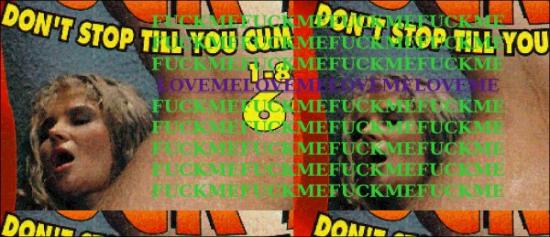
People who censor are often corporations flexing their muscle. One of the pieces in Art Direct … called BKPC used Barbie, Ken and G.I. Joe dolls. At some point the isp host, *the thing* received a letter from Mattel toys demanding that the site be removed for violation of copyright. I had to get a lawyer and send them a letter saying it was fair use and for them to back off. Luckily the people at the thing were not intimidated by Mattel so the site stayed up. By the way BKPC is about interracial sex so it makes people uncomfortable or it’s titillating. When I showed the physical work in a Christmas showed called Toys/Art/Us, I was asked by the curators to make sure that children could not view the art work. I did this by mounting the works in glassine sleeves on a podium that could only be seen by standing adults. I was lucky the curator wanted to show the work and was willing to work through the problem with me. In other cases the curator would not be that imaginative and simply shy away from showing anything that was vaguely controversial.

Another case of censorship was the Whitney Art Port an online new media projects gallery. I did a piece called Cocktail Party that featured synthetic voices in conversations as if they were drunk and at a cocktail party. I was asked to remove three sequences because of their sexual content. I wanted so much to be included in this project and the curator was a friend that I altered the piece, removing the offensive parts. The curator was afraid that the corporation would stop funding the project if I offended them with my overt content.
This happens all the time to every artist and it’s quite a dilemma. If you do the work unaltered it often means that you are not ever selected again for exhibitions. But then again Michelangelo had to paint a fig leave on the Sistine Chapel.
MC: The funding issue is interesting to me and seems to come up in many of your experiences. Censorship stories, as rarely as they are covered in the news, seem to focus heavily on the ideological component of censorship and whether public money should be used to fund controversial art. I’m interested to hear more about how anxieties regarding funding (public or private) influence curatorial decisions inside art institutions. I’m interested to hear your thoughts on this sort of economically determined censorship and its effects on art and public discourse around art. I’m also interested to know if these funding anxieties have worsened or changed as art institutions have switched over to the Arts management model and have made themselves so dependent on corporate sponsorship for programming?
GH: I did a large billboard piece called Hey Bozo… Use Mass Transit. It was five large billboards scattered around New York City to convince people to use mass transit. It was part of a competition put on every year by the MTA and Creative Time. I received an Honorarium of $500 and they produced the billboards. The piece caused such a stir that it was in the papers for a week straight and I was on TV on all the networks. One of the upshots was that conservatives wanted to know why public money was used to produce an artwork that insulted motorists and the other thing that happened was that Bozo the Clown tried to sue me for trademark infringement because I used the word Bozo. These are symptoms or indications of a deeper issue albeit a populist one. One the one hand you have a media figure (bozo the clown) who tries to sue anyone who uses the word Bozo. He’s got a sort of cottage industry. This is the way that corporations deal with the avant garde they can’t control. On the other hand you have mass media that tries to produce outrage in order to keep the attention of the population. This is also called delivering eyeballs and is a way to sell advertising. As you can see the main tool to attack an artist is money. either cut off funding or sue them. This is a way to stop them from getting their message out whatever that message might be. But there’s a flip side to this coin. We live in an information environment. There really is no way to stop information from coming out. It will be presented in a different venue for example the internet or in the case of art, alternative festivals, galleries etc.. So the idea of censorship is media specific or venue specific. It becomes a power game that is about who controls the venue and therefore controls the message. In this case it’s a reflection of the capitalist marketing system and art is a part of that system. But I see art as something beyond that system.

There are essentially two economies for art. One is the market for objects this includes galleries, museums, magazines and all the ancillary services of art fairs etc.. The other is the academic economy, which trains artists, curators and all the people interested in art. These systems shape what art is seen and what the content and style of the work is about. Both systems have self perpetuating mechanisms. In the market it is about the object. If you don’t make art that has a physical object you can’t be in the market. There is a component that has to do with entertainment and ticket sales in museums. This allows for installation and performance art as well as digital art and screen based art. Indeed, the economies of temporary museum spaces are a reflection of corporate manager style art.
The academic system on the other hand allows for artists who don’t necessarily fit the market to have some financial patronage by teaching. The problem is that the artist’s work and creativity is all about getting students to attend the university and their own class. This is another form of marketing.
I believe in a different type of art, an experimental, anarchic art that shakes things up and operates outside the existing art economies. In many instances this has been confused with the idea of an alternative life style that is a sort of well of inspiration for entrepreneurs looking for new products, ideas and people to sell to. Anarchic art is about something different it’s about challenging and critiquing the existing systems. Why? because I believe that art is about seeing things clearly and is one of the few areas that has freedom. That form of art becomes dangerous because it is uncontrollable. It can’t be packaged and marketed. That is why there is always a move towards censorship of radical art works.
There is also fake censorship or more precisely using outrage as a way to manipulate the art market. This is used successfully by people like Maurice Saatchi who had a show of his Young British Artists at the Brooklyn Museum. This show was also shown in England and there was outrage in London as well. The outrage in the US was about Cris Ofili’s use of elephant dung in a virgin mary painting. A nice piece of art that was about his African roots. The outrage in London was about a photograph that portrayed a famous criminal child murderer in England. The public and the press demanded the works be “censored.” The works themselves went up in monetary value because of the outrage. The position is that of an artist that uses an epatez de bourgeois position in their art. This reinforces the patron’s sense of being better than the masses. It is an elitist position. I happen to like the art works but the content of the pieces are standard for the art world. The Ofili piece is multiculturalism and the other work is punk. Both styles were first presented in the late 1970’s and I view these latest pieces as stylistically conservative.
As you can see the notion of censorship is more of an unfulfilled demand by an outraged person in the street than any sort of actuality when it comes to the marketing of objects. Those works that are actually censored one never sees or hears about.
MC: I’m interested in what you call “fake censorship” or the use of public and media outrage as a marketing tactic. I’m reminded of an article – http://rtmark.com/rockwell.html – by Jackie Stevens concerning “Paradise Now: Picturing the Genetic Revolution,” a 2000 Exit Art show concerning biotechnology. The article points out that, though the show included some very hard hitting criticisms of the biotech industry, it was nevertheless sponsored by biotech companies – companies that would have much to lose if consumers in the U.S. had the same sorts of concerns about biotechnology as some of the artists in the show. The obvious question of why would the biotech industry sponsor exhibitions that are openly critical of the industry’s practices is answered with the help of interviews with the chief biotech investor behind the show. Stevens writes, “The reason is simple: art about biotechnology, especially with a critical edge, serves to reassure viewers that serious concerns are being addressed. Even more importantly, biotech-themed art implicitly conveys the sense that gene manipulation is a “fact on the ground,” something that serious artists are considering because it is here to stay. Grotesque and perverse visuals only help to acclimate the public to this new reality.” I am also reminded of a transcript I used in a piece once in which a Sara Lee Corporation executive, speaking of the corporation’s “gifts” of impressionist art to the Art Institute of Chicago, stated, “Sara Lee’s art collection has made a statement – a quality statement – about our company. Art is all about excellence and vision and striving for perfection – the same standards that we uphold for our portfolio of leading brands. We are quite certain that the ‘brand names’ of Monet, Renoir and Degas have been a great complement to Sara Lee and have become icons of excellence that reflect our approach to doing business.” It seems that the mythology of fine art or the aura produced around fine art itself (namely, mythologies concerning artists being prophetic or ahead of their time, that art is about transcendence, universals, timelessness and so on) is a very useful context for the deployment of marketing schemes. Cases like these I’ve mentioned could almost make one nostalgic for old school censorship – the kind in which an authority comes down on an artist for producing work that is perceived as being offensive. At least in these scenarios the content is working – the work is having an effect. All this raises a couple of questions that I’d like to know your thoughts on. Firstly, do you agree with Stevens’ assessment that the content of an artwork as intended by the artist can be eclipsed (effectively censored) by the curator, sponsors and institutional framework surrounding the show and fine art itself, and if so, should artists be trained (in academia and elsewhere) to be able to anticipate how their work is being used in a larger context and be prepared to engage in content production beyond the frame (so to speak)? What are the lessons you have learned over the years in these regards?
GH: This goes back to Wittgenstein’s Dictum, “the meaning of a word is its’ meaning,” and “The meaning of a word is its’ use.”
Look at it another way Steve Kurtz http://www.caedefensefund.org was creating some bio-art that was also political when he was arrested. The event caused the USGOV to come down hard claiming he’s a bio-terrorist. The art world has rallied around Steve and is doing what it can to stop his persecution. Steve’s artwork was in process and never exhibited so you can’t say that it was censored and yet the USGOV is trying to pin a terrorist label on him. The context here is fluid between a media occurrence, freedom of speech, and forces of unreasonable paranoia. Steve and the people around him now have an ongoing performance work that is a cause celebre about free speech. In the end it doesn’t matter if anyone ever sees the actual work, the censorship and repressive activity of the USGOV is the key factor. When realpolitik comes up against art, art always loses. On another level both sides of the Steve Kurtz dilemma are winning because they are using the event to create meaning for their separate actions.
Back to your initial question which is the context created by the venue and the funders. There is always a deal struck between the funders/patrons/venues and the artists that show in the venues or accept support from the patrons. The patrons are seen as progressive and open because of their support of the arts. The artists are seen as giving their support/approval of the patron and the gallery system by participating in it. That’s the simple deal. The complex deal has to do with the content of the artwork. When the church is your patron you do religious paintings. When the Dutch merchants are your patrons you do domestic scenes. When the government is your patron you do heroic art that glorifies the government and its programs. In America the market has become the patron or more correctly corporate marketing capitalism and its technocratic bureaucrats/ managers are the patrons. The content of art reflects that reality.
However, there are many forms of art that operate outside these realities. The notion of experimental art is an art that doesn’t function in established arenas. Maybe we can call this theoretical art because it posits an art that can function outside of the normal venues set up for art.
In terms of censorship it may be more of a case of power and control. If one chooses to work in theoretical art one can expect no support from the existing patrons of the arts. This is a very fundamental struggle about who controls the meaning of art (content). Who controls the how, when and where of art? That is one of the reasons that I choose to work with the internet and digital art. The venues are much freer. There is little or no market action attached to this type of artwork. Indeed, this very interview is an artwork that uses the internet as its vehicle. I can state that it is an information/meditation that comes from the use of the networks. In this case it is an outgrowth of all the other communication artists that have come before me such as Fred Forest or, Joseph Bueys or Allan Kaprow.
MC: Earlier, you spoke of an anarchistic art practice that would function in opposition to the status quo. I’m assuming that this art practice would take on the political economic structure of an anarchist community. What might this look like? Are there examples of art subcultures that operate on anarchistic principles like anti-authoritarianism, free association, nonhierarchical organization, consensus decision making, egalitarianism, etc? I’m also interested in your estimation of online communities and new media art portals (like Rhizome.org for instance) who seem to reference some of these concepts in their mission statements yet seem to fall short in their editorial structure and policies. Perhaps, the concepts that sites like Rhizome imagine – decentralized and nonhierarchical – and indeed the internet itself seems to offer – would work in such stark contrast with what the dominant values of the fine art establishment (and our dominant political economic systems) that it becomes impossible to maintain funding, affiliations etc. Do you think the openness and opportunity for alternative systems and practices that electronic networks offer(ed) is now closing up, or do you see as much opportunity now as in the mid-to-late 90’s when it comes to networked art practice?
GH: There are many artists groups that are functioning at the moment. There is always a struggle and a dynamic where groups are involved. Rhizome has set up a sort of blog/news reporting website that has a brand name and a loose community around it. They have a mailist that functions somewhat as a place for critical discussion but the fundamental question is how does one move from discussion to action. The answer for rhizome is to be techno-centric and highlight emerging artists and technologies. They also spend a lot of time fundraising. The original project of rhizome by Mark Tribe was a simple anarchic mailist. This was also happening with nettime and thingist lists. There is one functioning now that is called [empyre] that comes out of Australia. Empyre was one of several list/communities that was featured during the documenta 6 in Kassel. I was actually involved in the discourse. My position was that I wanted to have my thoughts presented at the documenta http://magazines.documenta.de/frontend/article.php?IdLanguage=1&NrArticle=1718 .
There’s a back and forth flux on the internet that has some onerous aspects of fake digital democracy and fake creative freedom. This is web 2.0 where everyone can be creative and be content providers ala blogs and youTube etc.. This is the corporate bullshit of Facebook and Second Life. There’s an interesting piece in the Guardian about facebook that has be re-published on post.thing.net http://post.thing.net/node/1883 .
In any case, I am involved with three very vital digital art groups that have online/offline communities. One is called [PAM] http://perpetualartmachine.com – this is a video-artists community that has a physical kiosk presentation mode that is very much about non-hierarchical presentation. Another is locus sonus http://locusonus.org in France – that is an experimental sound art lab. I’ve also organized an artists group called Artists Meeting http://artistsmeeting.org that is just beginning to pick up steam. Part of what these groups are about is using the technology to create a media space for group interactions to occur. The funding model is pooling resources. I maintain the server nujus.net that Artists Meeting and locus Sonus use. The sysadmin is an engineering student in Split Croatia who is donating his services. Locus Sonus is funded by the French Cultural Ministry as an experimental lab. [PAM] got its’ start by being included in the SCOPE art fair and artists Meeting is bootstrapping it at the moment.
What these groups have in common is the notion of doing projects together rather than having an individual artists’ voice. I like to engage in both positions, that is, I do individual pieces and I do group works. Two previous projects are accessible on the web right now. One is called rantapod http://spaghetti.nujus.net/rantapod and is a series of performance/meditations that is downloadable to ipod. The other is called Art Dirt Redux http://spaghetti.nujus.net/artDirt, which is a podcast/sound art piece. These all challenge the art market in some way because they exist and are seen by large numbers of net audiences without any artworld support whatsoever. So I can say that the internet does still function as a good venue for experimental anti-hierarchical art.
MC: In preparing this conversation for publication I noticed that in one of your initial emails to me – before we actually started the interview – you stated that you’d been censored for not using particular software or hardware in the production or display of your work. I think this ties in nicely with our discussion concerning corporate funding, but something that seems more of an issue in new media art then anything else (I can’t imagine a paint company sponsoring a show and requiring the artists to only use their brand of paint). Perhaps you have some thoughts on this.
GH: There’s a lot of net.art and digital curators who set up defining parameters for new media shows. These often focus on a piece of hardware or a type of coding as an organizing principal. This plays into or is a symptom of the computer/technology scene where there are *platform* wars such as internet explorer vs. netscape or mac vs pc. There are software wars such as Dreamweaver vs GoLive. These competitions are about dominating a market. This also happens in digital art where a group of artists insist that for example they are the only net.art artists that exist and try to corner the market with the willing help of a number of curators. Often artists working in new media believe that you must write your own code in order to be a digital artist or you must use JAVA or you must use open source software or …. You get the idea. I remember once speaking at a panel where there was a net artist who was using perl and php and Peter Sinclair and I were using Max MSP. The other artist talked only about the coding structure. Our piece used custom built software as well but we were interested in the content and the user interactions. This happens all the time where a person mistakes writing code for art or insist that digital art is only code. It’s a rather boring discussion about hardware and software.
The original interview with G.H. Hovagimyan by Mark Cooley in 2008, can be seen here: http://flawedart.net/conversations/hovagimyan
G.H. Hovagimyan – nujus.net
Mark Cooley – FlawedArt.net
Main top image is from ‘A Soapopera for Laptops- A Soapopera for iMacs – Exercises in Talking’. A collaboration between Peter Sinclair and G.H. Hovagimyan. http://nujus.net/~nujus/html/soapopNu-2.html
This interview is licensed under a Attribution-Noncommercial-No Derivative Works 3.0 Unported
Image by Alice Alexandrescu.
This year’s edition of Artivistic brings the fields of art, politics and academia together under the theme of TURN*ON.
Eventually, the investigation about systems of representation – be they semiotic, informational or political – might slip into the one psychoanalysis considers the most elementary and surreptitious of them all: sex. That’s precisely where the Artivistic gathering got into in its fourth edition, which happened in Montreal from 15th to 17th October. To be exact, the theme under which the event tied the fields of art, politics and academia together was TURN*ON – according to its curatorial statement, ‘a fragile bridge extending, over a valley of which the depth you cannot see, to a life centered on pleasure, consciousness, togetherness, understanding, and joy’.
Formulated this way, the concept seems to be a response to the well-worn verses by journalist Eduardo Galeano, in which he states that utopia ’causes us to advance’ only because it ‘lies in the horizon’. With turn on, Artivistic proposes that the forces that move people forward and bring worlds into existence are not far away: in a scenario emptied of grand narratives, the desire (of the self?) should gain preponderance over any masterplans (of the party?).
So, if libido is the why, could we say that art is the how? As crude as it can be, this comparison makes clear that aesthetics, just as politics, mainly operate in the level of methods. They are more concerned with the way desire is manipulated (often repressed or enhanced) than with its ontological truth. Language cannot explain affect, and it shouldn’t pretend to – the best it can do is create spaces for its continuous exercise.
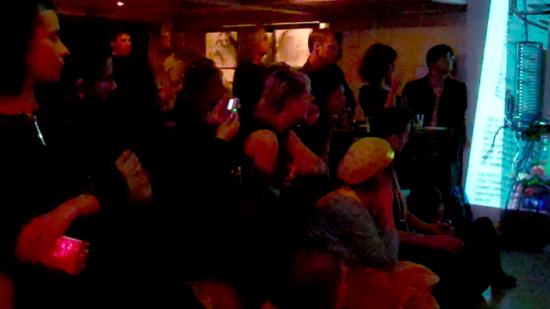
In that sense, what really stood out during the event were the workshops. I wouldn’t go as far as to agree with the idea that such activities are a distinct genre within the contemporary art circuit. Workshops indeed revitalize the exhibition space – however, they do so not by occupying it with new forms, but by proposing new forms of occupying it. In Artivistic, these interfaces ranged from diy electronics and card game design to pornographic filmmaking and even a kind of un-workshop on workshops! Among those, there was a remarkable amount of projects concerning the performative of one’s own identity.
In fact, the workshops punctuated Artivistic in a not much different way than the everyday activities of cooking and eating in group (or translating things to French or English – it was a true bilingual event). One thing led to another, keeping the gathering together in spite of the healthy excess of participant autonomy allowed by the organization crew. Of course, the concentration of (almost) all activities in the same place helped building this integration. This was a strategic option, very coherent with the intimate theme of this edition; the former Artivistic, about un.occupied spaces, had been distributed in different venues throughout Montreal.
The integration of the participants was so successful it had the minor side effect of creating an almost self-centred environment. Even though some activities would have been very interesting for people outside regular art-audience, it was hard to see among the public someone besides those that were immersed 24/7 in the event. For instance, it was a pity that the orgasmic birth workshop, which introduced alternative ways of pregnancy and labour, had no pregnant women participating.
This paradoxical isolation was imploded in the last night of the event – most ironically, not by the long-waited closing performance Resist Me Release Me: Turn On Act On, which artist Shu Lea Cheang had been organising with the participants throughout the gathering, but because of its impending cancellation. It seems that the managers of the venue where Artivistic was happening had not understood that the event would contain nudity and explicit sexual acts, and took account of this just in time of the final soiree. Since they had no public license to host this kind of activity, they said it was impossible to have the performance there: either it had to be suspended or transferred elsewhere.
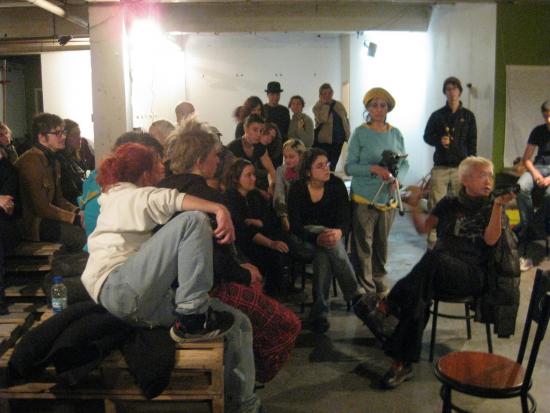
The organizers explained this incident to the participants and called for a collective decision. That immediately ignited a very intense discussion, where it became clear that what was at hand was not mere censorship, but a very subtle negotiation of the different spheres that Artivistic addressed. The autonomy people were requesting was not sexual, but artistic – ‘we do not intend to do an orgy, but performances’, as someone said. Hence, it was not a simple conflict between raw libidinal impulse and oppressive morality; it concerned more complex, structured systems – i.e. art and Montreal society, both already contradictory in themselves.
I dare say that some solutions proposed in this debate – for example, live-streaming the works from another place or ‘censoring’ performances in real-time – were way more interesting than any prescripted show might have been. These proposals were the sign of an art that was alive and kicking, ready to respond emergencies and fight back, instead of just claiming its secular, innocuous freedom (a freedom that critic Julian Stallabrass very cunningly regards as supplementary to that of the market).
The result was that in a couple hours the whole programme for the night was adapted and moved to a venue nearby, in a beautifully orchestrated, self-organized effort. Unfortunately, due to limitations of structure and space, not everything that had been planned before could be presented. Nevertheless, the accident had allowed the necessary hands-on without which a turn on just fades away, and something bigger was engendered in the process – I’d say revolutionary freedom, a kind of autonomy that, as the old leftist maxima states, must always be conquered.
Links:
Jeremy Bailey will be working as Artist in Residence at HTTP, Furtherfield’s Gallery and lab space, in Summer 2008. As part of the residency HTTP Gallery has commissioned a new satirical performance called Warmail which is the central piece in Bailey’s upcoming HTTP exhibition, The Jeremy Bailey Show in Autumn 2008.
The Jeremy Bailey Show, Bailey’s first solo exhibition in the UK, will present many of Bailey’s most recent works including VideoPaint 3.0 and SOS, alongside the new commission, Warmail, produced during his adjunct residency. This brand new performance work pokes fun at the value placed on “collaboration” in today’s art practice and policy-making. The performance will be staged live at the exhibition opening (Friday 19 September 2008, 7:30pm) and documented for viewing throughout the exhibition. Bailey plans to co-demonstrate, with his audience, new collaborative software that will allow participants to perform office related tasks such as email, word processing, or spreadsheets together while simultaneously composing a visual/musical score with matching choreography.
Jeremy Bailey received his MFA in Video Art from Syracuse University and an undergraduate degree in Visual Studies from the University of Toronto. He is co-founder of award winning artist video collective 640 480. His work has been described by Filmmaker Magazine as “a one man revolution on the way we use video, computers and our bodies to create art”. Bailey lives and works in Toronto, Canada.